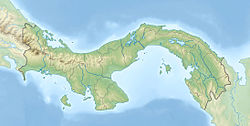| Panama Formation | |
|---|---|
| Stratigraphic range: Late Oligocene | |
| Type | Formation |
| Underlies | Caraba Formation |
| Overlies | Gatuncillo Formation, Cretaceous basement |
| Lithology | |
| Primary | Sandstone, shale, conglomerate |
| Other | Tuff, limestone |
| Location | |
| Coordinates | 9°06′N79°42′W / 9.1°N 79.7°W |
| Approximate paleocoordinates | 7°36′N77°18′W / 7.6°N 77.3°W |
| Region | Panamá Province |
| Country | Panama |
| Extent | Panama Basin |
| Type section | |
| Named for | Panama |
The Panama Formation (Tp) [1] is a geologic formation in Panama. The formation consists of tuffaceous [2] sandstones, conglomerates, tuffaceous shales and algal and foraminifera-rich limestones, [1] and preserves bivalve fossils of Leopecten gatunensis and Nodipecten sp. and dates back to the Late Oligocene period. [3]
